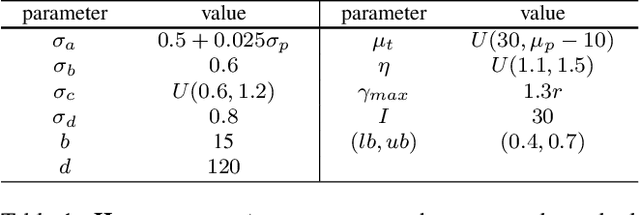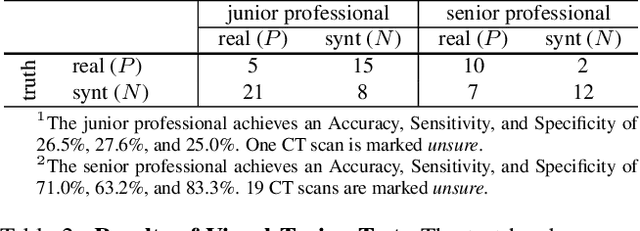Junfei Xiao
VideoAuteur: Towards Long Narrative Video Generation
Jan 10, 2025Abstract:Recent video generation models have shown promising results in producing high-quality video clips lasting several seconds. However, these models face challenges in generating long sequences that convey clear and informative events, limiting their ability to support coherent narrations. In this paper, we present a large-scale cooking video dataset designed to advance long-form narrative generation in the cooking domain. We validate the quality of our proposed dataset in terms of visual fidelity and textual caption accuracy using state-of-the-art Vision-Language Models (VLMs) and video generation models, respectively. We further introduce a Long Narrative Video Director to enhance both visual and semantic coherence in generated videos and emphasize the role of aligning visual embeddings to achieve improved overall video quality. Our method demonstrates substantial improvements in generating visually detailed and semantically aligned keyframes, supported by finetuning techniques that integrate text and image embeddings within the video generation process. Project page: https://videoauteur.github.io/
GenEx: Generating an Explorable World
Dec 12, 2024Abstract:Understanding, navigating, and exploring the 3D physical real world has long been a central challenge in the development of artificial intelligence. In this work, we take a step toward this goal by introducing GenEx, a system capable of planning complex embodied world exploration, guided by its generative imagination that forms priors (expectations) about the surrounding environments. GenEx generates an entire 3D-consistent imaginative environment from as little as a single RGB image, bringing it to life through panoramic video streams. Leveraging scalable 3D world data curated from Unreal Engine, our generative model is rounded in the physical world. It captures a continuous 360-degree environment with little effort, offering a boundless landscape for AI agents to explore and interact with. GenEx achieves high-quality world generation, robust loop consistency over long trajectories, and demonstrates strong 3D capabilities such as consistency and active 3D mapping. Powered by generative imagination of the world, GPT-assisted agents are equipped to perform complex embodied tasks, including both goal-agnostic exploration and goal-driven navigation. These agents utilize predictive expectation regarding unseen parts of the physical world to refine their beliefs, simulate different outcomes based on potential decisions, and make more informed choices. In summary, we demonstrate that GenEx provides a transformative platform for advancing embodied AI in imaginative spaces and brings potential for extending these capabilities to real-world exploration.
What If We Recaption Billions of Web Images with LLaMA-3?
Jun 12, 2024



Abstract:Web-crawled image-text pairs are inherently noisy. Prior studies demonstrate that semantically aligning and enriching textual descriptions of these pairs can significantly enhance model training across various vision-language tasks, particularly text-to-image generation. However, large-scale investigations in this area remain predominantly closed-source. Our paper aims to bridge this community effort, leveraging the powerful and \textit{open-sourced} LLaMA-3, a GPT-4 level LLM. Our recaptioning pipeline is simple: first, we fine-tune a LLaMA-3-8B powered LLaVA-1.5 and then employ it to recaption 1.3 billion images from the DataComp-1B dataset. Our empirical results confirm that this enhanced dataset, Recap-DataComp-1B, offers substantial benefits in training advanced vision-language models. For discriminative models like CLIP, we observe enhanced zero-shot performance in cross-modal retrieval tasks. For generative models like text-to-image Diffusion Transformers, the generated images exhibit a significant improvement in alignment with users' text instructions, especially in following complex queries. Our project page is https://www.haqtu.me/Recap-Datacomp-1B/
Medical Vision Generalist: Unifying Medical Imaging Tasks in Context
Jun 08, 2024



Abstract:This study presents Medical Vision Generalist (MVG), the first foundation model capable of handling various medical imaging tasks -- such as cross-modal synthesis, image segmentation, denoising, and inpainting -- within a unified image-to-image generation framework. Specifically, MVG employs an in-context generation strategy that standardizes the handling of inputs and outputs as images. By treating these tasks as an image generation process conditioned on prompt image-label pairs and input images, this approach enables a flexible unification of various tasks, even those spanning different modalities and datasets. To capitalize on both local and global context, we design a hybrid method combining masked image modeling with autoregressive training for conditional image generation. This hybrid approach yields the most robust performance across all involved medical imaging tasks. To rigorously evaluate MVG's capabilities, we curated the first comprehensive generalist medical vision benchmark, comprising 13 datasets and spanning four imaging modalities (CT, MRI, X-ray, and micro-ultrasound). Our results consistently establish MVG's superior performance, outperforming existing vision generalists, such as Painter and LVM. Furthermore, MVG exhibits strong scalability, with its performance demonstrably improving when trained on a more diverse set of tasks, and can be effectively adapted to unseen datasets with only minimal task-specific samples. The code is available at \url{https://github.com/OliverRensu/MVG}.
PaLM2-VAdapter: Progressively Aligned Language Model Makes a Strong Vision-language Adapter
Feb 16, 2024Abstract:This paper demonstrates that a progressively aligned language model can effectively bridge frozen vision encoders and large language models (LLMs). While the fundamental architecture and pre-training methods of vision encoders and LLMs have been extensively studied, the architecture and training strategy of vision-language adapters vary significantly across recent works. Our research undertakes a thorough exploration of the state-of-the-art perceiver resampler architecture and builds a strong baseline. However, we observe that the vision-language alignment with perceiver resampler exhibits slow convergence and limited scalability with a lack of direct supervision. To address this issue, we propose PaLM2-VAdapter, employing a progressively aligned language model as the vision-language adapter. Compared to the strong baseline with perceiver resampler, our method empirically shows faster convergence, higher performance, and stronger scalability. Extensive experiments across various Visual Question Answering (VQA) and captioning tasks on both images and videos demonstrate that our model exhibits state-of-the-art visual understanding and multi-modal reasoning capabilities. Notably, our method achieves these advancements with 30~70% fewer parameters than the state-of-the-art large vision-language models, marking a significant efficiency improvement.
A Semantic Space is Worth 256 Language Descriptions: Make Stronger Segmentation Models with Descriptive Properties
Dec 21, 2023



Abstract:This paper introduces ProLab, a novel approach using property-level label space for creating strong interpretable segmentation models. Instead of relying solely on category-specific annotations, ProLab uses descriptive properties grounded in common sense knowledge for supervising segmentation models. It is based on two core designs. First, we employ Large Language Models (LLMs) and carefully crafted prompts to generate descriptions of all involved categories that carry meaningful common sense knowledge and follow a structured format. Second, we introduce a description embedding model preserving semantic correlation across descriptions and then cluster them into a set of descriptive properties (e.g., 256) using K-Means. These properties are based on interpretable common sense knowledge consistent with theories of human recognition. We empirically show that our approach makes segmentation models perform stronger on five classic benchmarks (e.g., ADE20K, COCO-Stuff, Pascal Context, Cityscapes, and BDD). Our method also shows better scalability with extended training steps than category-level supervision. Our interpretable segmentation framework also emerges with the generalization ability to segment out-of-domain or unknown categories using only in-domain descriptive properties. Code is available at https://github.com/lambert-x/ProLab.
Rejuvenating image-GPT as Strong Visual Representation Learners
Dec 04, 2023Abstract:This paper enhances image-GPT (iGPT), one of the pioneering works that introduce autoregressive pretraining to predict next pixels for visual representation learning. Two simple yet essential changes are made. First, we shift the prediction target from raw pixels to semantic tokens, enabling a higher-level understanding of visual content. Second, we supplement the autoregressive modeling by instructing the model to predict not only the next tokens but also the visible tokens. This pipeline is particularly effective when semantic tokens are encoded by discriminatively trained models, such as CLIP. We introduce this novel approach as D-iGPT. Extensive experiments showcase that D-iGPT excels as a strong learner of visual representations: A notable achievement of D-iGPT is its compelling performance on the ImageNet-1K dataset -- by training on publicly available datasets, D-iGPT achieves 89.5\% top-1 accuracy with a vanilla ViT-Large model. This model also shows strong generalization on the downstream task and robustness on out-of-distribution samples. Code is avaiable at \href{https://github.com/OliverRensu/D-iGPT}{https://github.com/OliverRensu/D-iGPT}.
Label-Free Liver Tumor Segmentation
Mar 27, 2023



Abstract:We demonstrate that AI models can accurately segment liver tumors without the need for manual annotation by using synthetic tumors in CT scans. Our synthetic tumors have two intriguing advantages: (I) realistic in shape and texture, which even medical professionals can confuse with real tumors; (II) effective for training AI models, which can perform liver tumor segmentation similarly to the model trained on real tumors -- this result is exciting because no existing work, using synthetic tumors only, has thus far reached a similar or even close performance to real tumors. This result also implies that manual efforts for annotating tumors voxel by voxel (which took years to create) can be significantly reduced in the future. Moreover, our synthetic tumors can automatically generate many examples of small (or even tiny) synthetic tumors and have the potential to improve the success rate of detecting small liver tumors, which is critical for detecting the early stages of cancer. In addition to enriching the training data, our synthesizing strategy also enables us to rigorously assess the AI robustness.
CLIP-Driven Universal Model for Organ Segmentation and Tumor Detection
Jan 06, 2023Abstract:An increasing number of public datasets have shown a marked clinical impact on assessing anatomical structures. However, each of the datasets is small, partially labeled, and rarely investigates severe tumor subjects. Moreover, current models are limited to segmenting specific organs/tumors, which can not be extended to novel domains and classes. To tackle these limitations, we introduce embedding learned from Contrastive Language-Image Pre-training (CLIP) to segmentation models, dubbed the CLIP-Driven Universal Model. The Universal Model can better segment 25 organs and 6 types of tumors by exploiting the semantic relationship between abdominal structures. The model is developed from an assembly of 14 datasets with 3,410 CT scans and evaluated on 6,162 external CT scans from 3 datasets. We achieve the state-of-the-art results on Beyond The Cranial Vault (BTCV). Compared with dataset-specific models, the Universal Model is computationally more efficient (6x faster), generalizes better to CT scans from varying sites, and shows stronger transfer learning performance on novel tasks. The design of CLIP embedding enables the Universal Model to be easily extended to new classes without catastrophically forgetting the previously learned classes.
AsyInst: Asymmetric Affinity with DepthGrad and Color for Box-Supervised Instance Segmentation
Dec 07, 2022Abstract:The weakly supervised instance segmentation is a challenging task. The existing methods typically use bounding boxes as supervision and optimize the network with a regularization loss term such as pairwise color affinity loss for instance segmentation. Through systematic analysis, we found that the commonly used pairwise affinity loss has two limitations: (1) it works with color affinity but leads to inferior performance with other modalities such as depth gradient, (2)the original affinity loss does not prevent trivial predictions as intended but actually accelerates this process due to the affinity loss term being symmetric. To overcome these two limitations, in this paper, we propose a novel asymmetric affinity loss which provides the penalty against the trivial prediction and generalizes well with affinity loss from different modalities. With the proposed asymmetric affinity loss, our method outperforms the state-of-the-art methods on the Cityscapes dataset and outperforms our baseline method by 3.5% in mask AP.
 Add to Chrome
Add to Chrome Add to Firefox
Add to Firefox Add to Edge
Add to Edge